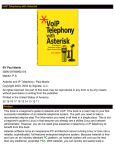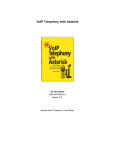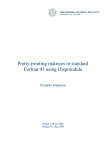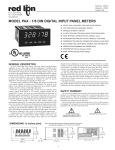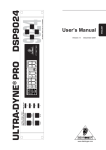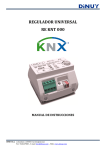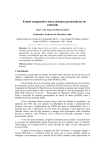Download Dispmodule User Manual
Transcript
Dispmodule User Manual Kristján Jónasson Report VHÍ-01-2008 Reykjavík, May 2008 Report VHÍ-01-2008, Reykjavík May 2008 Kristján Jónasson. DISPMODULE User Manual. Engineering Research Institute, University of Iceland, Technical report VHI-01-2008, May 2008. Kristján Jónasson, associate professor, Department of Computer Science, Hjardarhagi 4, IS-107 Reykjavik, Iceland. Email: [email protected]. The author is responsible for the opinions expressed in this report. These opinions do not necessarily represent the position of the Engineering Research Institute or the University of Iceland. Copyright Kristján Jónasson, 2008. The software described in this user manual is free and distributed with the following license: “Permission to use, copy, modify, and/or distribute this software for any purpose with or without fee is hereby granted, provided that the above copyright notice and this permission notice appear in all copies. The software is provided ‘as is’, and the author disclaims all warranties.” The software is available on the author’s web page, www.hi.is/~jonasson. Engineering Research Institute, University of Iceland, Hjarðarhagi 4, IS-107 Reykjavík, Iceland CONTENTS 1. Introduction ............................................................................................................................................... 4 2. Usage ......................................................................................................................................................... 5 2.1 Overview of modules........................................................................................................................... 5 2.2 An example program ........................................................................................................................... 5 2.3 Displaying data of non-default kind .................................................................................................... 6 3. Subroutine DISP........................................................................................................................................ 6 3.1 Simple calls ......................................................................................................................................... 6 3.2 Call with complete list of arguments ................................................................................................... 8 3.3 ASTERISK_UNIT and NULL_UNIT............................................................................................... 11 3.4 PUTSTR_UNIT: Output with user written subroutines .................................................................... 11 3.5 Using w=0 editing.............................................................................................................................. 11 3.6 Not-a-number and infinite values ...................................................................................................... 12 4. Controlling default settings − DISP_SET and DISP_GET ..................................................................... 12 4.1 The derived type DISP_SETTINGS.................................................................................................. 12 4.2 Calling syntax for DISP_SET............................................................................................................ 12 4.3 The function DISP_GET ................................................................................................................... 13 5. Numbers to strings................................................................................................................................... 13 5.1 Introduction ....................................................................................................................................... 13 5.2 The function TOSTRING.................................................................................................................. 14 5.3 The subroutines TOSTRING_SET and TOSTRING_SET_FACTORY........................................... 14 5.4 TOSTRING examples ....................................................................................................................... 15 6. Testing the modules................................................................................................................................. 16 6.1 Checking DISPMODULE only ......................................................................................................... 16 6.2 Complete checking ............................................................................................................................ 17 6.3 Displaying from Matlab mex files..................................................................................................... 17 References ................................................................................................................................................... 17 Appendix. Contents of README file........................................................................................................ 17 3 1. INTRODUCTION DISPMODULE is a standard Fortran 95 module for quick and easy displaying (“pretty-printing”) of numbers, vectors or matrices using default or specified format. It can be useful for debugging, purposes, for preliminary display of numerical results, and even for final display of such results in cases when carefully formatted tables are not needed. It is comparable to the automatic matrix printing of Matlab, S and R, but offers substantially more control over the format used. The module can handle the standard Fortran data types integer, single precision, double precision, complex, logical and character. Integer, real, complex and logical data of other than default kind are supported with add-on modules. The module contains the following public procedures: Subroutine DISP Subroutine DISP_SET Subroutine DISP_SET_FACTORY Function DISP_GET Function TOSTRING Subroutine TOSTRING_SET Subroutine TOSTRING_SET_FACTORY The main procedure used for displaying items Used to change default settings for DISP Restores DISP-settings to original (factory) default Returns a structure with current DISP-settings Returns a string representation of a scalar or vector Used to change default settings for TOSTRING Restores TOSTRING-settings to original default In addition the module defines a public derived type, DISP_SETTINGS, used for saving and restoring settings for DISP. The procedures DISP and TOSTRING have a generic interface and optional arguments, so the same subroutine / function name, is used to display items of different data types and ranks, with or without labels, and using default or specified format. Similarly DISP_SET is generic and can be used both to change individual settings and to restore previously saved settings. The most basic calling syntax for displaying is CALL DISP(expression) which will display the expression with default format. The format may be specified with CALL DISP(expression, edit-descriptor), and CALL DISP(title, expression) will label the displayed item with a title. Examples are CALL DISP(A), CALL DISP(A,'F9.3'), CALL DISP('A=',A) and CALL DISP('A=',A,'F9.3'), the last one specifying both title and format. If aij = exp(i + j − 1) , i, j = 1,…,4, then CALL DISP('A = ', A) writes out: A = 2.72 7.39 20.09 54.60 7.39 20.09 54.60 148.41 20.09 54.60 148.41 403.43 54.60 148.41 403.43 1096.63 and if bij = exp(ij ) the result of CALL DISP(B) is: 2.71828E+0 7.38906E+0 2.00855E+1 5.45981E+1 7.38906E+0 5.45981E+1 4.03429E+2 2.98096E+3 2.00855E+1 4.03429E+2 8.10308E+3 1.62755E+5 5.45981E+1 2.98096E+3 1.62755E+5 8.88611E+6. It is also possible to number the rows and columns: CALL DISP(A, STYLE='NUMBER') will give: 1 2 3 4 1 2.72 7.39 20.09 54.60 2 7.39 20.09 54.60 148.41 3 20.09 54.60 148.41 403.43 4 54.60 148.41 403.43 1096.63. The selection between F and E editing depends on the size of the largest displayed element as discussed in section 3.2 below. Among the settings that may be controlled is the spacing between columns, the number of significant digits, the placement of the label, and the file unit where the output goes. Items can in addition be displayed side by side, for example: 4 CALL DISP('X = ', X, ADVANCE='NO') CALL DISP('Y = ', Y) which might output: X = 7 4 1 8 0 3 3 2 6 Y = 11 2 7 Complex numbers are formatted as illustrated by: complex C(3,3) forall(i=1:3, k=1:3) C(i,k)=log(cmplx(-i*k))**k call disp('C = ', C, 'F0.3') which will display C = 0.000 + 3.142i 0.693 + 3.142i 1.099 + 3.142i -9.389 + 4.355i -7.948 + 8.710i -6.659 + 11.258i -31.203 - 19.631i -47.300 - 0.749i -54.449 + 14.495i Infinite and not-a-number real values are supported and displayed as NaN, +Inf or –Inf. The remaining sections in this user manual contain detailed information on using the module. Section 2 discusses the basics of using the module, including use statements, compiling and linking, and add-on modules supporting non-default kinds of data. Section 3 gives a detailed description of the generic subroutine DISP. All the possible arguments are listed and the purpose of each one described. Section 4 describes how to change various settings that control how items are displayed with DISP. Section 5 describes the function TOSTRING which may be used to change numbers to strings. Finally testing of the module is discussed in section 6. 2. USAGE 2.1 Overview of modules The major part of the package is the module DISPMODULE in the file dispmodule.f90. This module should be referenced with a use-statement, USE DISPMODULE, and the file should be compiled and linked with other files. To display non-default kinds of data the add-on modules described in section 2.3 below must also be used. The file dispmodule.f90 actually begins with two auxiliary modules, PUTSTRMODULE and DISPMODULE_UTIL. The first one contains two dummy subroutines, PUTSTR and PUTNL, which do nothing, but must be incorporated to avoid an “undefined symbol” link error. In addition it defines the named constant (parameter) DEFAULT_UNIT = −3, which makes the asterisk unit (usually the screen) the default to display on. The second auxiliary module has utility procedures which are not accessible to the user. Alternatively the user can write his own PUTSTRMODULE as described in section 3.4 below. An example is near the beginning of dispmodule.f90 (commented out). It may be used (by commenting it in, and commenting the default module out) to allow Matlab mex files to display in the Matlab command window. 2.2 An example program Following is a short example program that uses the package: PROGRAM EXAMPLE USE DISPMODULE REAL :: A(3) = (/ 1.2345, 2.3456, 3.4567 /) CALL DISP('A = ', A, SEP=', ', ORIENT = 'ROW') END PROGRAM EXAMPLE If this program is in a file example.f90 and the Gnu Fortran compiler is used with Unix, the following commands will accomplish compiling, linking and executing (the $-symbols are operating system prompts): 5 $ gfortran -c dispmodule.f90 $ gfortran -o example example.f90 dispmodule.o $ ./example Alternatively the compiled modules may be placed in a library that is included when linking: $ $ $ $ gfortran -c dispmodule.f90 ar -r libdispmodule.a dispmodule.o gfortran -o example example.f90 -L. -ldispmodule ./example The program should write out “A = 1.23450, 2.34560, 3.45670”. The package also contains a little longer example program (in dispdemo.f90) with a makefile. On Unix with gfortran, the command: $ make demo compiler=gfortran should compile, link, and run dispdemo. The makefile’s default compiler name is f95. 2.3 Displaying data of non-default kind The Fortran standard only guarantees the support of one kind of integers, logicals and characters, and two kinds of real and complex numbers (the standard mentions double precision complex numbers, and reading between the lines their support is almost deducible, though not directly guaranteed). The size of default kind integers, logicals and single precision reals is with most (if not all) computers / compilers either 4 or 8 bytes, and many (if not all) computers / compilers support other kinds of integers covering the range of byte lengths 1, 2, 4 and 8. The support of 1 byte logicals is also common, and some computers / compilers have quadruple precision reals. Support of these “non-standard” kinds is provided by the add-on modules DISP_I1MOD, DISP_I2MOD, These assume that the following hold: DISP_I4MOD, DISP_I8MOD, DISP_L1MOD and DISP_R16MOD. SELECTED_INT_KIND(2) → 1 byte integers SELECTED_INT_KIND(4) → 2 byte integers SELECTED_INT_KIND(9) → 4 byte integers SELECTED_INT_KIND(18) → 8 byte integers SELECTED_REAL_KIND(25) → 16 byte reals (quad LOGICAL(1) → 1 byte logicals precision) If this is not the case, or support for other kinds is wanted, then the files must be edited to obtain what is desired. To use any of these modules, reference them with use-statements: USE DISP_xxMOD, compile them and link with the program. With a little editing effort it is also possible to combine (a subset of) them with DISPMODULE in a single module − the details are left to the user. 3. SUBROUTINE DISP This is the principal subroutine of the package. It has various control arguments that specify the exact format of the output. Most of these may also be used as arguments of the subroutine DISP_SET. When used with DISP, a control argument affects only the item being displayed with the current call, but when used with DISP_SET, the default settings for subsequent DISP calls are affected. The default values for individual arguments given below are used unless they have been changed by a call to DISP_SET. All character arguments should be of type default character. An overview of the arguments is in table 1, and further details are in sections 3.1−3.5. 3.1 Simple calls CALL CALL CALL CALL CALL DISP DISP(X) DISP(TITLE, X) DISP(X, FMT) DISP(TITLE, X, FMT) 6 Table I. Arguments of subroutine DISP (all are optional). Argument Type Length Kind Rank TITLE Character Integer Real Complex Logical Character * Character Possible values Default Purpose Empty Label to use for X Default 0 Any Any 0, 1 or 2 Any * Default 0 FMT_IMAG Character * Default 0 ADVANCE Character ≤6 Default 0 NO, YES or DOUBLE YES X FMT Item to display Depends Valid edit descriptor on X and DIGMAX Depends Valid edit descriptor on X and DIGMAX DIGMAX Integer Default 0 1, 2,… , 90 6 LBOUND Integer Default 1 Any [1] or [1,1] ORIENT Character 3 Default 0 ROW or COL COL SEP Character ≤9 Default 0 Any STYLE Character ≤9 Default 0 LEFT, ABOVE, PAD, UNDERLINE or NUMBER — can be combined, e.g. PAD & NUMBER TRIM Character ≤4 Default 0 YES, NO or AUTO UNIT Integer Default 0 ≥ −3 ZEROAS Character Default 0 Any ≤9 LEFT Edit descriptor for an element of X (real part if X is complex) Edit descriptor for imaginary parts of elements of X Stay on same line, advance to next line, to next line but one? Number of significant digits to show for Xelement of largest absolute magnitude Numbers of first row / column of X Display row vector or column vector? String used to separate matrix columns Placement and form of title; should rows / columns be numbered? Trim blanks from left of X? (AUTO means trim if FMT is absent) ASTERIS External file unit to send K_UNIT output to String to display instead of zeros AUTO The first call advances to the next line, and the other calls display X on the default unit (the unit may be changed with the UNIT argument). The default putstrmodule (see section 2) sets the asterisk unit (usually the screen) to be default. The purpose of individual arguments is as follows: TITLE Provides a label for X. The label prefixes X by default but this may be changed with the STYLE argument (see examples in section 3.2). When X is absent TITLE must also be absent. X The item to be displayed. X may be scalar, vector or matrix (i.e. of rank ≤ 2) and the following kinds of data are supported: default integer default real (or single precision, real(kind(1.0))) double precision real (or real(kind(1d0))) default complex (or complex(kind(1.0))) double precision complex (or complex(kind(1d0))) default logical default character 7 With the add-on modules described in section 2.3 other kinds may be displayed. Matrices are displayed in traditional mathematical order, so the rows displayed are X(1,:), X(2,:) etc. Vectors are by default displayed as column vectors (but a row orientation may be specified with the ORIENT argument). An SS edit descriptor is applied automatically so positive elements are not prefixed with a + sign (the Fortran standard makes outputting a + sign optional). FMT When present, FMT should contain an edit descriptor that will be used to format each element of X (or the real parts of X in case X is complex and FMT_IMAG is present; see below). The possible edit descriptors are: Fw.d, Dw.d, Ew.dEe, ENw.dEe, ESw.dEe: real data (the Ee suffixes are optional) Iw, Bw, Ow, Zw: integer data (all may be suffixed with .m) Lw: logical data A, Aw: character data Gw.d, Gw.dEe: any data Example calls for numeric X are CALL DISP(X,'ES11.4') and CALL DISP('X=',X,'F8.4'). If X is a scalar string (i.e. of rank 0) and TITLE is absent FMT must be specified with a keyword (otherwise the call is taken to have TITLE and X): CALL DISP('str',FMT='A4') displays “ str” but CALL DISP('str','A4') displays “strA4”). If FMT is absent, each element of X is formatted with a default edit descriptor. When X is of type logical the default is L1 and when it is of type character the default is A (which is equivalent to Aw where w = LEN(X)). For integer data the default is Iw where w is exactly big enough to accommodate both the largest positive and the largest negative values in X. For real and complex data the default also depends on the largest absolute values in X, as detailed in the DIGMAX-paragraph in section 3.2. The format used for complex numbers is demonstrated in the introduction above. 3.2 Call with complete list of arguments CALL DISP (TITLE, X, FMT, FMT_IMAG, ADVANCE, DIGMAX, LBOUND, ORIENT, SEP, STYLE, TRIM, UNIT, ZEROAS) All dummy arguments are optional and some of them are incompatible with some data types of X. The arguments control how X is displayed, as described in section 3.1 and below. For the character arguments ADVANCE and ORIENT the case of letters is ignored (so e.g. ADVANCE = 'yes' and ADVANCE = 'YES' are equivalent). Normally argument association for arguments after FMT (or FMT_IMAG) will be realized with argument keywords, e.g. CALL DISP('X=', X, DIGMAX=3, ORIENT='row'). When X is a scalar string FMT must also be associated with keyword, as mentioned in section 3.1. The most useful application of calling DISP with X absent is to advance to the next line or display an empty line. For this purpose, the only relevant arguments are UNIT, and ADVANCE with the value 'yes' or 'double'. FMT_IMAG = edit-descriptor-imag An edit descriptor for imaginary parts of complex X. The statement CALL DISP((1.31,2.47),'F0.1','F0.2') will display “1.3 + 2.47i”. If FMT_IMAG is absent and FMT is present then both real and imaginary parts are edited with FMT. If both are absent, separate defaults are used, as explained in the DIGMAX-paragraph below. FMT_IMAG must be absent if X is not complex. ADVANCE = adv The value for adv may be 'yes', 'no' or 'double'. If the value is 'yes' then X is written out immediately, if it is 'double' then X is written out followed by an empty line (thus giving double spacing), and if it is 'no' then X is not written out until the next DISP call on the same unit with advancing turned on (either by default, via a call to DISP_SET, or via the ADVANCE keyword). When this occurs, all the items displayed with DISP since the last output occurred on the unit are written out side by side, separated by three spaces unless a different separation has been specified via the MATSEP argument of DISP_SET. Default value of ADVANCE is 'yes'. 8 DIGMAX = n Controls the format used for real and complex data in the absence of FMT. For real items the format is chosen so that the displayed number of largest absolute magnitude (say xmax) has n significant decimal digits. If 0.1 ≤ xmax < 10n an F edit descriptor is used, otherwise an E edit descriptor. For complex items these rules are applied separately to the real parts and imaginary parts, and thus two different formats are used. When X is not of real or complex type the argument DIGMAX is ignored. When DIGMAX is present FMT should be absent. The default is n = 6. LBOUND = lbound This argument is a default integer vector with the numbers of the first row / column to show when displaying with numbered style. When calling subroutines in Fortran, only the shape of matrix arguments is passed with the arguments, but matrix lower bounds are assumed to be 1 unless declared explicitly in the routine. To compensate for this deficiency lbound may be set to the declared lower bound(s) of X. To take an example, let aij = exp(i + j − 1) as in section 1, but let A be declared with REAL::A(0:3,0:3). Then CALL DISP(A, STYLE = 'NUMBER', LBOUND = LBOUND(A)) will display: 0 1 2 3 0 1.000 2.718 7.389 20.086 1 2.718 7.389 20.086 54.598 2 7.389 20.086 54.598 148.413 3 20.086 54.598 148.413 403.429. In fact the call may be shortened to CALL DISP(A, LBOUND = LBOUND(A)) because numbering is default when LBOUND is present. ORIENT = ori This argument can only be used when X is a vector (i.e. has rank 1). If ori is 'col' (the default) a column vector is displayed, and if ori is 'row' a row vector results. SEP = sep Specifies a string which is written out between columns of displayed matrices. If X has rows (−1, 3) and (5, 10) and sep is ', ' then the output will be: -1, 5 5, 10 The length of the string must be at most 9. Default is ' ' (character string with two spaces). STYLE = style There are five possible styles: 'left' 'above' 'pad' 'underline' 'number' Title is immediately to the left of the first line of the displayed item. Title is centred immediately above the item. Title is centred above the item, padded with hyphens (-). Title is centred above the item, underlined with hyphens. Each matrix or vector row and / or column is numbered. Any of the four title position styles can also be combined with the number style by specifying for example STYLE = 'pad & number'. Any character except space may be used instead of hyphen by prefixing it to the style. STYLE = '*underline' will thus underline the title with asterisks. Both row and column numbers appear for numbered matrices, but for vectors only row numbers appear (or column numbers when ORIENT is 'col'). The five styles are illustrated below, accompanied by an example of combined padded title and numbering. Matr = 1.2 5.6 4.2 18.3 Matr 1.2 4.2 5.6 18.3 ---Matr-1.2 4.2 5.6 18.3 Matr --------1.2 4.2 5.6 18.3 1 2 1 1.2 5.6 2 4.2 18.3 ____Matr____ 1 2 1 1.2 4.2 2 5.6 18.3 The default value of style is 'left' if LBOUND is absent, 'number' if it is present, and 'left & number' if both TITLE and LBOUND are present. 9 TRIM = trim This argument can take three values, 'YES', 'NO' and 'AUTO'. When YES is specified, each column of displayed items is trimmed from the left, with 'NO' the items are not trimmed and if trim is 'AUTO' the items are trimmed when FMT is absent but not when it is present. In the following example, X and U are displayed with trim = 'yes', but Y and V with trim = 'no'. In all cases the edit descriptor is the default (I4). The default is TRIM = 'AUTO'. ----X---1 2 4 2 22 34 3 32 1234 -------Y-----1 2 3 2 22 34 3 32 1234 -----U----333 22 4444 -------V-----333 22 4444 One application of trimming is to display matrices with a fixed number of fractional digits but variable effective field width. Then Fw.d editing with w big enough is accompanied by TRIM = i 'yes'. An example is the following display of a matrix with (i, k) element exp(k ) using F20.2 and 'yes': power exponentials 2.72 7.39 20.09 2.72 54.60 8103.08 Similar output may be obtained using I and F edit descriptors with w = 0 as discussed in section 3.5. Apart from I and F edited displays, it is possible to trim A-edited displays as well as E-edited displays with some negative elements, but the first column all positive: With TRIM='yes': X=1.2e+5 -4.1e-2 2.3e-3 8.6e+1 With TRIM='no': X= 1.2e+5 -4.1e-2 2.3e-3 8.6e+1 UNIT = external-file-unit The unit which the output is sent to. There are three special units, which may be referred to either with constants or parameters (named constants) as follows: Constant −3 −2 −1 Parameter ASTERISK_UNIT PUTSTR_UNIT NULL_UNIT Preconnected unit The asterisk unit (often the screen) The subroutines PUTSTR and PUTNL Null device (all output to this is discarded) These units are further described in sections 3.3 and 3.4. Other unit numbers correspond to external files that should have been connected with open-statements. The default unit depends on the named constant DEFAULT_UNIT, defined in PUTSTRMODULE. The default PUTSTRMODULE sets it to −3 (see sections 2 and 3.4). ZEROAS = zerostring Supported for integer and real items (not complex). Any element that compares equal to 0 will be displayed as zerostring. If, for example, A is a 4 by 4 upper triangular matrix with aij = 1 max(0, j − i + 1) then call disp('A = ', A, 'F0.3', zeroas = '0', advance = 'no') and call disp('B = ', A, 'F0.3', zeroas='.') will display: A = 1.000 0 0 0 0.500 1.000 0 0 0.333 0.500 1.000 0 0.250 0.333 0.500 1.000 B = 1.000 . . . 0.500 1.000 . . 0.333 0.500 1.000 . 0.250 0.333 0.500 1.000 Notice that when zerostring contains a decimal point it is lined up with other decimal points in the column. If zerostring has length 0, the default behaviour of not treating zeros specially is reestablished, in case an earlier DISP_SET call has been used to set ZEROAS. 10 3.3 ASTERISK_UNIT and NULL_UNIT As already mentioned in section 3.2 there are three special units, ASTERISK_UNIT = −3, PUTSTR_UNIT = −2 and NULL_UNIT = −1. These public named constants (parameters) are defined by DISPMODULE. Selecting ASTERISK_UNIT channels all output to the unit that WRITE(*,...) statements use. The ISO_FORTRAN_ENV intrinsic module of Fortran 2003 defines the named constant OUTPUT_UNIT and this may be used instead, unless its value is set to −2 by the compiler (which would clash with PUTSTR_UNIT). Selecting NULL_UNIT causes all output via DISP to be discarded. This feature makes it simple to turn the output on and off, which may be useful for debugging and testing purposes. If UNIT = U is specified in all DISPcalls, it is enough to change the value of U to −1 to turn off output. 3.4 PUTSTR_UNIT: Output with user written subroutines One of the purposes of the PUTSTR_UNIT is to make displaying possible in situations where ordinary printand write-statements do not work. This is for example the case in Matlab mex-files (in fact the execution of a write statement on the asterisk unit crashes Matlab). To use the PUTSTR_UNIT it is necessary to write two subroutines with interfaces: SUBROUTINE PUTSTR(S) CHARACTER(*), INTENT(IN) :: S SUBROUTINE PUTNL() The first of these should output the string S, and the second one should advance output to the next line. These subroutines should be placed in a module PUTSTRMODULE as explained in section 2. The module should also define a named constant DEFAULT_UNIT, which could be set to −2 to make the PUTSTR_UNIT default. An example that works with g95 and Matlab mex-files is: MODULE PUTSTRMODULE integer, parameter :: default_unit = -2 CONTAINS subroutine putstr(s) character(*), intent(in) :: s call mexprintf(s//char(0)) end subroutine putstr subroutine putnl() call mexprintf(char(10)//char(0)) end subroutine putnl END MODULE PUTSTRMODULE At the beginning of the file dispmodule.f90 there is a slightly longer version which works with both g95 and gfortran. Testing this module is discussed in section 6.2 below. 3.5 Using w=0 editing The Fortran standard stipulates that writing a single element with I0 editing results in the smallest field width that accommodates the value, and the same applies to B0, O0, Z0 and F0.d editing. With DISP, the width of a displayed column will be the width of the widest field in the column, and each element is right-adjusted in the column. This gives exactly the same output as using TRIM='yes' and a specified field width bigger than the largest occurring. Note that with F0.d editing, there is no limit on the width of a column, but with Fw.d and TRIM='yes' any element wider than w will be displayed as w asterisks: ------------------F0.2------------------ -----F13.2, TRIM='yes'---14.28 142857142857142857142857.14 0.47 14.28 ************* 0.47 1.42 1414213562.37 0.69 1.42 1414213562.37 0.69 11 3.6 Not-a-number and infinite values If the compiler supports not-a-number and infinite values as defined by the IEEE exceptional values of Fortran 2003, these are displayed as NaN, +Inf or –Inf. A not-a-number value X is identified as being not equal to itself, and an infinite value is either greater than HUGE(X) or smaller than –HUGE(X). On all the compilers tried the sequence BIG=1E20; CALL DISP(EXP(BIG)) displays +Inf, and the program segment: REAL :: Z = 0, BIG = 1E20 CALL DISP((/Z, Z/Z, BIG, -EXP(BIG)/)) displays 0.00000E+00 NaN 1.00000E+20 -Inf 4. CONTROLLING DEFAULT SETTINGS − DISP_SET AND DISP_GET The subroutine DISP_SET may be used to change default values of all the arguments of DISP except TITLE, X, FMT and LBOUND. In addition the default separator between items that are displayed side-by-side (using ADVANCE='no') may be changed with the MATSEP argument. 4.1 The derived type DISP_SETTINGS DISPMODULE contains the following definition of the data type DISP_SETTINGS. TYPE DISP_SETTINGS character(3) :: advance character(9) :: matsep character(3) :: orient character(9) :: sep character(19) :: style character(4) :: trim character(9) :: zeroas integer :: digmax integer :: matseplen integer :: seplen integer :: unit integer :: zaslen END TYPE DISP_SETTINGS = = = = = = = = = = = = 'YES' ' ' 'COL' ' ' 'LEFT' 'AUTO' '' 6 3 2 -3 0 Structures of type DISP_SETTINGS may be used to save and later restore format control settings of DISP. As shown, new variables of this type will automatically have default values for all components. 4.2 Calling syntax for DISP_SET There are two ways to call DISP_SET: CALL DISP_SET(SETTINGS) CALL DISP_SET(ADVANCE, DIGMAX, MATSEP, ORIENT, SEP, STYLE, UNIT, ZEROAS) Both calls change the default format control used in subsequent calls to DISP. In the first call, SETTINGS is of type DISP_SETTINGS and the default values for all arguments is changed. In the second call all the arguments are optional. If an argument is absent the corresponding default setting is not changed. An example call is CALL DISP_SET(STYLE = 'pad', SEP = ' '). The effect is that titles will be written padded above matrices, and matrix column will be separated by one blank. The type and purpose of all the arguments except MATSEP has been described in section 3.2. 12 MATSEP = ms Specifies a character string of length ≤ 9 that is written out between items (matrices) when they are displayed side-by-side. An example is: CALL CALL CALL CALL DISP(X, ADVANCE='NO') DISP(Y, ADVANCE='NO') DISP_SET(MATSEP=' | ') DISP(Z, ADVANCE='YES') The output from these calls might be: 12.2 | 1.3 | 1 9.6 | 13.0 | 3 -2.0 | 4.0 | 4 Note that MATSEP affects the separation of all items that have been placed in the output queue of the unit being displayed on. 4.3 The function DISP_GET The argumentless function DISP_GET returns the current default settings in a structure of type DISP_SETTINGS. If a subroutine changes the default settings with DISP_SET it is possible to save the settings that are in effect when the routine is entered, and restore these settings before returning from the routine. An example is: subroutine disp_xy(x,y) use dispmodule real x(:,:), y(:,:) type(disp_settings) ds ds = disp_get() call disp_set(digmax=4, sep=',') call disp('x=',x) call disp('y=',y) call disp_set(ds) end 5. NUMBERS TO STRINGS 5.1 Introduction Many programming languages have built-in functions that change numbers to strings. It is for instance possible with Matlab to write s = ['The square of ' num2str(x) ' is ' num2str(x*x)]; disp(s) and in Java one may write String s = "The square of " + Float.toString(x) + " is " Float.toString(x*x); System.out.println(s) (or in fact even shorter: System.out.println("The square of " + x + " is " + x*x);). Both program fragments will display “The square of 1.5 is 2.25”. It is possible to achieve a similar effect in Fortran using internal files and list-directed output: character(100) s real :: x = 1.5 write(s, *) 'The square of', x, 'is', x*x print *, trim(s) but this is cumbersome, and also there is the disadvantage that the result is compiler-dependent. 13 DISPMODULE has a function, TOSTRING, which overcomes this disadvantage and offers additional With x = 1.5 the following statement will produce the same output as Matlab and Java give: flexibility. call disp('The square of '//tostring(x)//' is '//tostring(x*x)) Because Fortran 95 does not have variable length strings, using TOSTRING lacks some of the possibilities of the Java and Matlab functions. However, TOSTRING is compatible with the ISO_VARYING_STRING module, and if this is available one may for example obtain the same output as above with: use iso_varying_string type(varying_string) :: xs, x2s ... x = 1.5 xs = tostring(x) x2s = tostring(x**2) print *, 'The square of'//xs//' is '//x2s TOSTRING accepts integer, logical or real scalars or vectors. The subroutine TOSTRING_SET may be used to change settings for TOSTRING. 5.2 The function TOSTRING Apart from the item to be turned into a string, an edit descriptor to use can optionally be supplied as the second argument to TOSTRING. The two ways to invoke TOSTRING are: TOSTRING(X) TOSTRING(X, FMT) These invocations return a character string representing the value of the argument X. When X is a vector individual elements are separated by a string, with the original (or factory) default value ", ". By (original) default, G editing is used to convert real numbers, I editing integers, and blanks are trimmed from (each element of) X, both from the left and the right. In addition trailing zeroes are trimmed from the fractional part of real X-elements, as well as a trailing decimal point. The separating string, trimming behaviour, and default editing may be changed by calling TOSTRING_SET X The item to be changed to a string. X may be a scalar or a vector (i.e. of rank 0 or 1) and of one of the following kinds: default integer default real (i.e. real(1.0), single precision) double precision real (i.e. real(1d0)) default logical FMT Character string with an edit descriptor used to format each element of X. The possible edit descriptors are given in section 3.1, except that A and Aw can of course not be used. When FMT is absent, a default edit descriptor is used. The default may be set by calling TOSTRING_SET but the original (or factory) defaults are I0 for integers, L1 for logicals and 1PG12.5 for reals. 5.3 The subroutines TOSTRING_SET and TOSTRING_SET_FACTORY The subroutine TOSTRING_SET has five arguments, all of which are optional. Argument association will normally be realized using argument keywords, e.g. CALL TOSTRING_SET(SEP='; '). The examples in section 5.4 clarify how to use this subroutine. The five arguments are: SEP Character string used to separate elements of displayed vectors. Original default value is ', '. 14 RFMT Character string containing default edit descriptor to use to display real items. The original default value is '1PG12.5' IFMT Character string containing default edit descriptor to use to display integer items. The original default value is 'I0'. TRIMB Controls whether leading and trailing blanks are trimmed from individual displayed elements. Possible values are 'YES' (to trim blanks) and 'NO' (for no trimming). Default is 'YES'. TRIMZ Controls whether trailing zeros are trimmed from the fractional part of displayed items. Possible values are 'NONE' (for no zero trimming), 'G' (to trim fractional trailing zeros only when G editing is used), and 'ALL' (to trim zeros with all types of editing). Trailing decimal points are also removed when zero-trimming is active. Default value is 'G'. The subroutine TOSTRING_SET_FACTORY (which has no arguments) may be called to restore all settings of TOSTRING to the original default values (the factory defaults): SEP=', ', RFMT='1PG12.5', IFMT= 'I0', TRIMB='YES' and TRIMZ='G'. 5.4 TOSTRING examples When the original (factory) defaults are in effect, the result of invoking TOSTRING will usually be as follows. Invocation Returned string tostring(atan(1.0)) tostring(exp([-3.,-1.,0.,1.])) tostring(real([(i,i=1,5)])**8) tostring([1.23456,1.2300,1.23456e6]) tostring(real([(i,i=1,5)])**8,'f0.1') tostring(real([(i,i=1,5)])**8,'f6.1') tostring([1200000.,-1.2e-9]) ! tostring(1.200d103) tostring([1.1d0,2.2d10,3.3d20]) ! tostring(-77) tostring([(i,i=-3,3)]**11) tostring([(i,i=-3,3)]**11, 'i7') tostring([(i,i=-3,3)]**11, 'i4') ! tostring((1,3)/(4,2)) tostring(cmplx((/-1,-2/))**0.25) ! tostring([.true., .false., .false.]) tostring(.true., 'L2') '0.785398' '4.97871E-02, 0.36788, 1, 2.7183' '1, 256, 6561, 65536, 3.90625E+05' '1.2346, 1.23, 1.23456E+06' '1.0, 256.0, 6561.0, 65536.0, 390625.0' '1.0, 256.0, 6561.0, ******, ******' '1.2E+06, -1.2E-09' '1.2+103' '1.1E+00, 2.2E+10, 3.3E+20' '-77' '-177147, -2048, -1, 0, 1, 2048, 177147' '-177147, -2048, -1, 0, 1, 2048, 177147' '****, ****, -1, 0, 1, 2048, ****' '0.5 + 0.5i' '0.70711 + 0.70711i, 0.8409 + 0.8409i' 'T, F, F' 'T' The returned strings may be slightly different from the ones shown, because some compilers (at least some versions of g95) will produce one more decimal place in a few cases, and because the Fortran standard allows G editing to give exponent fields in the form ±0dd instead of ±Edd. The examples make use of brackets to construct vector constants (a Fortran 2003 feature). If the compiler being used does not support this, (/ and /) must be used instead. Notice that trimming is on by default so there is not much purpose in specifying the format for integers and logicals. Notice also that (usually) 5 significant digits are displayed when the default G editing results in F edited output, but 6 digits for the numbers of small or large magnitude, displayed with E editing. This discrepancy is present in the Fortran standard; the presence of the scale factor 1P in the edit descriptor increases the number of displayed significant digits. Examples of using TOSTRING_SET follow (again the returned string may be slightly different). 15 Invocation call tostring_set(sep=';') tostring([1,2,30]) ! call tostring_set(trimb='NO') tostring(real([(i,i=1,5)])**8,'f6.1') tostring([1,2,30],'i3') tostring([(i,i=-3,3)]**11, 'i4') tostring([1,2,30],'i0') tostring(.true.,'L3') ! call tostring_set(trimz='NONE',sep=', tostring(real([(i,i=1,4)])**8) tostring([1.23456,1.2300,1.23456e6]) tostring(1.200d103) ! call tostring_set(trimz='ALL') tostring(real([(i,i=1,5)])**8,'f0.1') ! call tostring_set(rfmt='G12.4') tostring(real([(i,i=0,5)])**8) tostring([1200000.,-1.2e-9]) ! call tostring_set_factory() Returned string '1;2;30' ' 1.0; 256.0;6561.0;******;******' ' 1; 2; 30' '****;****; -1; 0; 1;2048;****' '1;2;30' ' T' ',trimb='YES') '1.0000, 256.00, 6561.0, 65536.' '1.2346, 1.2300, 1.23456E+06' '1.20000+103' '1, 256, 6561, 65536, 390625' '1, 256, 6561, 0.6554E+05, 0.3906E+06' '0.12E+07, -0.12E-08' 6. TESTING THE MODULES The package has been checked successfully with four different compilers, g95, gfortran, ifort from Intel and f95 from Nag. The g95 compiler has been used on Windows, Ubuntu Linux and Sun Solaris, gfortran on Windows and Ubuntu Linux, ifort on Windows and an AMD-64 computer with Suse Linux and the Nag compiler on Windows only. There is one named constant at the beginning of the test programs which may be changed. This is the parameter verbose. When verbose is 2, the results of all tests are reported on the screen, when verbose is 1 (the default) the report is much more concise, and when it is 0 the report is minimal (and a few tests are bypassed). In all cases the report ends with “OK” if all tests are passed, otherwise it ends with assertion failure information. 6.1 Checking DISPMODULE only The display modules are accompanied by a test program in the file test_dispmodule.f90. The test program is fairly comprehensive, and tries to test all the features of DISPMODULE. Thus all public procedures are called with and without all optional arguments, and for those arguments that have a limited range of allowed values (such as ADVANCE, STYLE and TRIM) all these values are tried. In addition the tests check all the examples that are given in this user manual. However, it is obviously impossible to test all possible combinations of arguments and argument values, so one must be content with a partial test, accompanied by examination of the source code of the modules and the test program. To check only DISPMODULE (not the add-on modules), test_dispmodule should be compiled and linked with With the Gnu Fortran compiler and Unix give the commands: dispmodule. $ gfortran -o test test_dispmodule.f90 dispmodule.f90 $ ./test It is also possible to use Make, with the command (again assuming the Gnu compiler): $ make check compiler=gfortran. 16 6.2 Complete checking To check also the add-on modules and displaying of NaN-s and infinities it is easiest to use Make, which works if the compiler has a pre-processing option (most compilers do). Use one of the make-commands: $ $ $ $ make make make make check-all-kinds check-quadprec check-naninf check-naninf-ieee possibly adding an option to select the compiler and/or editing the makefile to select the add-on modules to link with the program (needed if default integers are 8 bytes). The first listed make command checks displaying of 1, 2, 4 and 8 byte integers, single and double precision reals and 1 byte logicals, the second one checks displaying of quaruple precision reals, and the last two check displaying of nan-s and infinities (use checknaninf-ieee if the compiler supports Fortran 2003 ieee_arithmetic). It is also possible to carry out complete checking manually, by un-commenting (some of) the “use disp_...” statements, changing the kind parameters (irange or sik, logikind and srk) near the beginning of test_dispmodule.f90, and linking with the needed add-on modules. With some compilers / computers it may be necessary to make changes to definitions of kind parameters in the add-on modules (and the test program). 6.3 Displaying from Matlab mex files There is a separate example program of calling DISP from a Matlab mex file in mexdispdemo.f90. This has been tested with g95, gfortran and ifort on Windows. To run this example one must first set up the Matlab mex command for Fortran compilation, and for the testing this has been done with gnumex (see gnumex.sourceforge.net). Also one needs to use the PUTSTRMODULE that is commented out at the start of DISPMODULE (or with g95 the one given in section 3.4) instead of the dummy version. Having made these preparations one can issue from the Matlab prompt the commands: >> mex -c dispmodule.f90 >> mex mexdispdemo.f90 dispmodule.obj >> mexdispdemo(hilb(3), 1:4) Mexdispdemo simply displays its arguments, which should be a matrix and a vector. REFERENCES [1] Kristján Jónasson. Pretty-printing matrices in standard Fortran 95 using DISPMODULE. Engineering Research Institute, University of Iceland, Technical report VHI-02-2008, May 2008 APPENDIX. CONTENTS OF README FILE README file for DISPMODULE package LICENSE Copyright (c) 2008, Kristján Jónasson, Dept. of Computer Science, University of Iceland ([email protected]). Permission to use, copy, modify, and/or distribute this software for any purpose with or without fee is hereby granted, provided that the above copyright notice and this permission notice appear in all copies. The software is provided "as is", and the author disclaims all warranties. (Explanation: I wanted a short license, to emphasize that the package is free and that people could add it to commercial packages if they wished. I did a little browsing and found this license text, called the "ISC licence". I have shortened the no-warranty clause. K.J.) 17 The files in the package are all contained in the same folder. They are the following: FORTRAN 95 MODULES (THE "ALGORITHM IMPLEMENTATION"): dispmodule.f90 Principal module of package disp_i1mod.f90 Add-on module for 1-byte integers disp_i2mod.f90 Add-on module for 2-byte integers disp_i4mod.f90 Add-on module for 4-byte integers disp_i8mod.f90 Add-on module for 8-byte integers disp_l1mod.f90 Add-on module for 1-byte logicals disp_r16mod.f90 Add-on module for quad precision reals DOCUMENTATION dispmodule-userman.doc dispmodule-userman.pdf dispmodule-userman.html dispmodule-userman.txt dispmodule.doc changelog.txt User manual in Word 2003 format User manual in pdf format User manual in html User manual in plain text format Paper submitted to TOMS in April 2008 Textfile detailing changes since version 0.00 (submitted to TOMS originally) EXAMPLE DRIVER dispdemo.f90 expected-demo-output.txt Fortran 95 main program demonstrating usage File with expected output from the demo program TESTING MATERIAL test_dispmodule.f90 test_dispmodule_fpp.F90 test_naninf.f90 test_naninf_ieee.f90 test_naninf_mod.f90 mexdispdemo.f90 test-all.sh Principal test. Checks correctness of principal module Checks correctness of add-on modules (needs Fortran preprocessor) Checks displaying of nans and infinities with non-ieee compilers Checks displaying of nans and infinities on ieee supporting compilers Module used by test_naninf.f90 and test_naninf_ieee.f90 Program for testing displaying from a Matlab mex-file A shell script that runs a full set of tests MAKEFILE ("COMMAND FILE") Makefile Makefile (gnu-make) for example driver and test programs. EVIDENCE OF PORTABILITY AND CONFORMANCE TO FORTRAN 95 STANDARD portability-evidence.txt Results of running test-all.sh on 5 different compiler/platform combinations POSSIBLE MAKE COMMANDS The default compiler name is f95 and the default platform is Unix/Linux. It is assumed that gnu make is used (on some systems one should use gmake instead of make). If this is the case one may issue: make make make make make make demo check check-all-kinds check-quadprec check-naninf check-naninf-ieee Compile, Compile, Compile, Compile, Compile, Compile, link link link link link link and run example driver and run "principal test" and run checks of principal and add-on-modules and run checks of quadruple precision display and run checks of nan and infinities display & run checks of nan and infinities display (ieee compilers) For other compilers or on Microsoft Windows with make installed (e.g. cygwin / mingw), one can issue, for example: make demo compiler=g95 platform=windows make check compiler=nag make check compiler=ifort It may also be necessary to edit the makefile. Apart from "compiler" and "platform" is is possible to set values of the makefile variables "optimize", "debug", "fflags" and more. See the makefile itself for more information and examples. Author: Kristjan Jonasson, Dept. of Computer Science, University of Iceland ([email protected]). 18


















